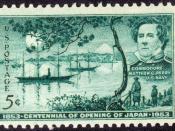In 1854, Commodore Matthew Perry and the U.S. Navy arrived near Edo, requesting that Japan open its ports to the United States. The superior military force of the United States left Japan almost no choice but to comply with the U.S.. A year later, the U.S. Navy forced the shogun to ratify the Treaty of Peace and Amity. The encounter and treaty with the United States marked the beginning of the path towards a new, democratic Japan that would attempt to adopt elements of Western civilization and combine them with Japan's traditions and morality. The steps that Japan took towards cultural modernity would help the nation become one the great powers that it is today.
The first step towards cultural modernity would be the elimination of the shogunate, a system of government that is based around feudal military totalitarianism, and the removal of the Tokugawa system of guilds & protective associations.
The Japanese looked for an alternate form of government while examining the potential advantages and dangers presented by engaging foreign morals and ideologies into their new government.
The Charter Oath of 1868 declared the enthronement of the Emperor and outlined the goals that would be met by the Meiji government. It listed that all matters would be decided by open discussion, all social classes would unite as one, the common people would be allowed to pursue their self-interests, all base customs (that are seen as uncivilized) would be removed and all laws and customs would have to conform to the principles of international justice. The last goal was to seek knowledge from all around the world to strengthen the Japanese foundation. The Oath listed very rational goals that would help maintain social integrity and nationalism as the western nations had when they made their transitions from feudalist states to...


